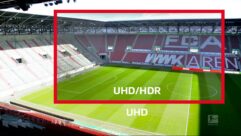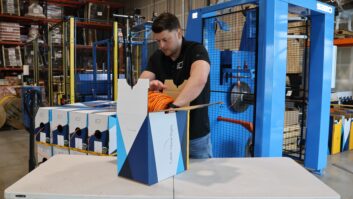
In this edition of the SVC Podcast, SVC Contributing Editor Bennett Liles talks with Bill Scott, the audiovisual technician for the San Diego Opera Company about its new Clear-Com Tempest 2400 digital wireless intercom with seamless roaming. Scott outlines the setup of the system and how the antennas are connected for coverage in various areas away from the stage. He also discusses the channel assignments for stage crew, set crew and lighting for coordination during the opera productions.
Links of interest:
- The San Diego Opera with schedule for the coming show season
- The Clear-Com Tempest 2400 Digital Wireless intercom system
- The Clear-Com SG-100 dongle used to link the base stations
- The CCT-RT Remote Antenna Transceiver
Download Podcast Here:
https://s3.amazonaws.com/nb-svc/public/public/11_12_13-Bill-Scott_SD-Ope…
Nov 12, 2013 11:17 AM,
With Bennett Liles

Listen to the Podcasts
|
Editor’s note: For your convenience, this transcription of the podcast includes timestamps. If you are listening to the podcast and reading its accompanying transcription, you can use the timestamps to jump to any part of the audio podcast by simply dragging the slider on the podcast to the time indicated in the transcription.

Clear-Com’s Tempest 2400 digital wireless Intercom with the new Seamless Roaming capability provides San Diego Opera with interference-free communications across multiple productions spaces for all its productions.
When the San Diego Opera is doing a show, there’s a lot more going on behind the scenes than most people are aware of. Dozens of crew technicians have to be in realtime communication and a new Clear-Com system is getting the job done. Bill Scott is here to give us the details, coming right up on the SVC Podcast.
SVC: Bill, welcome to the SVC Podcast and thanks for being with us from the San Diego Opera Company.
Bill Scott: My pleasure.
Yeah, tell us a little about the San Diego Opera.
We do a four-show season and perhaps a special event like a concert or something. So our season runs from the first part of January until the first part of May, then we take a hiatus. The stage crew, then, is off until the production season comes around again. It’s been a little while, but we’re looking forward to the upcoming season starting in January.
Well, after all they do out there it’s probably good to take a breather for part of the year.
Coming up is our 50th season, so that’s quite an accomplishment for an opera company; 50 years in business and we’re going strong. It’s a seasonal thing. There’s a time when you’re out of production. You have to be. I mean production is so intense that you’d never be able to prep for a new season or the next series of shows if you didn’t have some time off, for some of the people anyway. The creative people need that time to put together new productions. [Timestamp: 1:52]
If you were doing all of that year-round it would probably work you to death.
Yeah.
As the AV technician for the opera, what all do they have you doing there?
Well, on the video side, I’m providing images of one of two things; either I’m providing an overview shot of the stage, which several departments need to see, or I’m providing an image of the maestro. And of course singers, choruses, stage management, they need to be in constant contact with the maestro and it’s done through a visual, so they know where he is. On the video side I start out with like, I think, 28 permanent-installed video monitors that show one of those two images and I add on from there. Generally, 90 percent of the time, it’s the maestro image that needs to be placed so that a chorus master—because they move the choruses all over the place backstage—wherever they plant that chorus or that band or that musician, somebody needs to see the maestro because he runs the show and then they just have to see him. Probably the most usual request I’ve had—it’s not a request, it’s a demand to put a monitor here—is when we did Moby Dick, there was a scene where Captain Ahab is laying on his back on a table or a desk or something and he’s looking straight up into the flies. He needed to see the maestro. So as he lays on his back he had to see a video monitor directly over his head, which was put on a line set. And you know it’s 30ft.-35ft. or so above him, but he can see it and he could sing without having to look at the maestro. He can sing while lying flat on his back. So it’s that type of thing, anyplace. Now on the audio side, when I met the general director, who is still my general director today, the first thing he said to me was, “I understand that you have many duties on the stage. I’m not concerned with that.” He goes, “What I want from you is I want you to give me good broadcastable recordings of these performances because that’s going to help us sell tickets.” So that’s always been my primary mandate, as far as I’m concerned, to provide a broadcastable product that our audience and potential audience will enjoy to bring people into the theater.
Now as far as the fundamentals of the job, the main thing would be providing the orchestra on stage for the singers to hear, so that’s just speakers that the singers can listen to. And then the audio signal is distributed to countless places. I mean it goes to everything from front of house to the concession stands to the dressing rooms to stage management needs to hear it, and importantly people like opera techs. The gentleman that’s projecting the titles that are translating the libretto, he absolutely has to hear and see the maestro. He’s reading music just like the stage managers are, to follow along. And then I can’t even think of every place else, but whoever needs an audio signal it goes to them and that’s pretty simple to do, just send a mix some place and put a speaker there or whatever. Then also in the audio side is the communications. All the stage personnel, etc., need to be tied together with a communication system. We use Clear-Com at the San Diego Opera. [Timestamp: 5:28]
Nov 12, 2013 11:17 AM,
With Bennett Liles

And you had a recent addition I believe, the Tempest 2400 digital wireless intercom from Clear-Com. What’s been the biggest improvement that you’ve seen with the addition of that wireless system?
Probably the biggest improvement is the lack of interference. You know, not having the communication stepped on by other wireless entities that are outside of our company that we can’t control. That was always a problem. Range was another problem with the UHF systems, people getting out of range. It’s kind of hard to imagine if you haven’t worked in the environment, but opera is so vast in terms of the personnel that it takes to put on a show that communications are just needed virtually every place in the theater and they all need to be in touch with management, whether it’s stage management or production management, whoever. It all has to be tied together. The Tempest 2400 has just given us all the versatility we need to do that because with the UHF system, you were tied to at most two channels. Well with the 2400 you have four channels. You don’t have people talking over one another. You have people on discreet channels that are just listening for what they need to listen to. Opera production is very complicated and it takes a complicated system to make it, I guess, less complicated for lack of a better word. [Timestamp: 6:59]
That’s a lot of RF floating around there what with mics and intercom and other things.
It’s a tremendously heavy RF environment. Like any major city in a downtown area, you have just countless potential for RF interference with everything from the way you expect with the police and fire and all that, but then like in San Diego, we have the Navy, which is an incredible entity using RF in our environment. And of course being a large city we have the full complement of digital television transmissions and yes, it’s a very, very heavy RF environment. [Timestamp: 7:38]
That would be a big factor in setting the system up, but then you’ve got the frequency-hopping scheme that the Tempest 2400 works on so that probably makes things a little easier.
Right. I mean as a user you’re not really aware of the frequency hopping, it just does its job. And so you don’t have that type of interference that we used to have; the squelch in your ear and so forth that everybody always would think that something was wrong with the system as soon as they heard it. There was always that type of situation, but that has gone to zero with the Tempest system. [Timestamp: 8:13]
And with its seamless roaming I think you can walk through something like 16 different coverage areas with no drop-outs.
I don’t know if that’s the maximum, but we certainly have established the zones that we need. If you’re in proximity to a base station, you have no problem connecting to it and transmitting and receiving from it. But if you go to an area that’s not in the influence of that particular base station, you would be out of range. But if you remote the antennas off of that base station into the area, then when you walk into that area you are still connected. The way that’s done is just by literally taking the antennas and placing them in whatever area you need to access. In our case it’s the rehearsal hall, the trap room, or the basement, the dressing rooms, the stage management offices, which are on the second floor of the theater. We need consistent communication in all of those areas. [Timestamp: 9:16]
Do you run coax to those?
You run Cat cable. You either run Cat-5 or Cat-6 cable to that antenna off the back of the base station and that’s all it takes. It couldn’t be simpler.
Sounds like it and once you get it set up and all the wiring dressed away it’s just dealing with all the different users. How do you have the channels assigned between lighting people and sound, set people and all of those?
With the Tempest system, you have either a 4-channel beltpack or you have a 2-channel beltpack. The 2-channel beltpacks can be assigned to any of the same channels that the four channels are assigned to. In other words, the four channels A, B, C and D, your two channel can be assigned to B and C or even C and D or A and D—whatever you choose. It’s really so simple to do that. The way we have it broken out is what you expect. Stage management is on channel A. They’re the most important factor in the production and everybody needs to know where to find them and so they basically are on channel A. And then B might be the prop department and they need to talk amongst themselves so they may just be on B. Our electrics crew is on C and channel D would be our carpenter crew. So somebody like myself, I just generally stay on A because people that are going to directly communicate with me most often will be stage management. So it just depends on who you need to listen to, but it’s just simplified the whole process. [Timestamp: 10:50]
Did you already have an existing Clear-Com system that you integrated the Tempest into?
In the theater and the opera company we have always had Clear-Com. It’s bulletproof equipment permanently installed in the theater. I have the same amplifier that I’ve been using for 30 years. It’s been on virtually every day. It does not quit. I’ve never had a service call on that equipment. [Timestamp: 11:12]
That’s pretty much what I hear from everybody.
Why would you use anything else? This stuff is amazing. And so we expect the same results out of the Tempest. I had used a Clear-Com wireless product that I purchased over 20 years ago and it was a VHF wireless system and it was a six-beltpack system, and it was a fabulous system. That one is still working. If I need to I’ll pull that out of storage at this point and integrate it right into the system without thinking a thing about it because it’s VHF, so it’s still available frequencies and it still works. And I may need it because believe it or not, I can put 25-plus people on wireless for a production. All of a sudden they want six carpenters doing this particular thing, moving this particular unit, and so they’ve got to be on wireless. They can’t be dragging cables across the stage. And yes, the whole system is integrated into a wired system. I happen to have a 4-channel wired system and it connects to it just beautifully. [Timestamp: 12:21]
When you brought the new system in and set it up, how did everybody take to it? Was the learning curve manageable?
The quick overview I gave them was, “Here’s your volume; here’s your talk button and here’s how you change channels.” And then I went to each person and took time to ask them what they needed and it’s all available right there on the beltpack. With the push of a couple of buttons I set the thing to do exactly what they want it to do. Not only that is you have the software, so I can literally see every beltpack and every base station and what it’s doing in realtime. [Timestamp: 13:01]
Makes all the difference when you can concentrate on communication and not on how to handle the communication. Appreciate your telling us about it, Bill. Bill Scott with the San Diego Opera and their new Clear-Com Tempest 2400 digital wireless intercom system. We’ll talk later about how you get set up for a show. Thanks for being with us.
Thank you.








